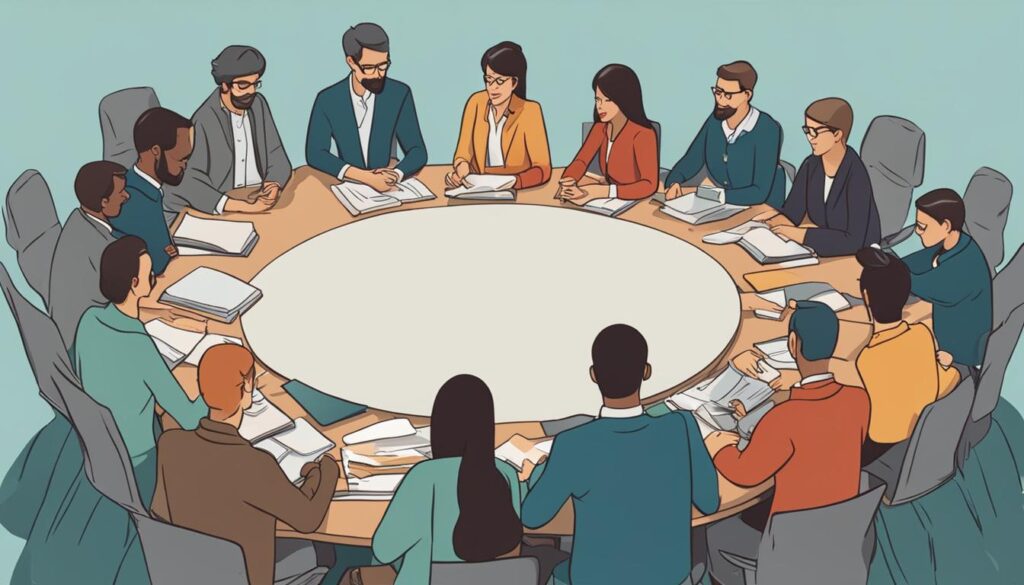Introverts have unique needs when it comes to social interactions and energy preservation. They thrive in quieter, more introspective environments and may feel drained by constant social engagement. As a leader or team member, it’s crucial to create an inclusive work environment that respects introverts’ boundaries and allows them to contribute in a way that aligns with their energy levels. But how can you include introverts without draining their energy?
In this article, we will explore nine simple strategies for including introverts in team dynamics, fostering better collaboration, and improving communication. By implementing these tips, you can create introvert-friendly environments where introverts feel valued, comfortable contributing their ideas, and most importantly, energized.
Let’s dive in:
Key Takeaways:
- Offer meaningful roles that cater to introverts’ strengths and interests
- Provide defined time limits for interaction to respect introverts’ boundaries
- Schedule breaks during longer engagements to allow introverts to recharge
- Check in privately about comfort level to address introverts’ needs
- Suggest occasional lower-key joint interests to create an inclusive environment
Offer meaningful roles, not just socializing
Introverts have unique qualities and strengths that can be utilized in the workplace. Instead of solely focusing on social activities, it is important to offer introverts meaningful roles that align with their energy preservation and strengths.
For example, you can assign introverts tasks that require deep focus and analysis, such as data analysis or research projects. By providing them with independent and analytical tasks, introverts can make valuable contributions to the team without feeling drained by constant social interaction.
By recognizing and utilizing introverts’ unique strengths, you can create an inclusive work environment that allows introverts to thrive. This fosters better collaboration and communication within the team, as each member feels valued and respected for their individual strengths.
Table: Comparison between social activities and meaningful roles for introverts at work
| Social Activities | Meaningful Roles |
|---|---|
| Team lunches and happy hours | Data analysis and research projects |
| Large group discussions | Independent problem-solving tasks |
| Networking events | In-depth research and report writing |
By offering these meaningful roles, you not only respect introverts’ need for energy preservation and solitude, but also maximize their potential for contribution. This creates a more introvert-friendly environment where introverts can connect with their work and make a significant impact on the team’s success.
Provide defined time limits for interaction
When collaborating with introverts, it is crucial to establish clear boundaries and define time limits for social interactions. This allows introverts to effectively manage their energy levels and prevent overstimulation. By implementing this practice, you create a more inclusive and supportive work environment for introverts.
For example, when scheduling team meetings or brainstorming sessions, ensure that they have specific time slots that don’t run longer than necessary. By doing so, introverts know exactly when they need to engage and can plan their energy accordingly. This empowers them to participate fully without feeling overwhelmed or drained.
Transparently communicate these time limits to the entire team, emphasizing the importance of respecting them. Encourage team members to plan their contributions within these defined windows, allowing introverts to manage their energy effectively. By setting clear boundaries and providing structured time limits, introverts can thrive in team collaborations while maintaining their well-being.

| Benefits of providing defined time limits for interaction |
|---|
| 1. Allows introverts to manage their energy levels effectively |
| 2. Prevents overstimulation and feeling overwhelmed |
| 3. Creates an inclusive work environment |
| 4. Facilitates active participation from introverts |
| 5. Supports introverts in maintaining their well-being |
By implementing defined time limits for interaction, you demonstrate respect for introverts’ boundaries and contribute to effective collaboration in the team.
Schedule breaks during longer engagements
Extended social engagements or team-building activities can be exhausting for introverts, leading to a depletion of their energy. To prevent this, it’s important to schedule regular breaks throughout these longer events, allowing introverts the opportunity to recharge and regain their energy levels.
For example, during a full-day team retreat, incorporate designated break times where participants can take a moment to themselves. This time can be used by introverts for solitude, quiet reflection, or engaging in activities that help them recharge, such as taking a walk or reading a book.
By including these breaks, you create a more inclusive environment that supports introverts’ need for downtime and prevents the exhaustion that can come from constant social interaction. Giving introverts the opportunity to recharge ensures that they are able to fully participate and contribute their best ideas and efforts to the team.
Check in privately about comfort level
Introverts may feel uncomfortable in certain social situations or overwhelmed by excessive stimulation. It’s essential to check in with them privately to see how they’re feeling and offer support.
For example, if you notice an introverted team member appearing drained or experiencing an “introvert hangover” after a particularly social event, reach out to them individually. Ask how they’re doing and if there’s anything you can do to assist or make them feel more comfortable.
| Benefits of checking in privately: |
|---|
| 1. Allows introverts to express their feelings openly and honestly. |
| 2. Shows introverts that you care about their well-being and comfort. |
| 3. Provides an opportunity to offer support and assistance tailored to their needs. |
| 4. Strengthens the bond of trust between introverts and their colleagues. |
By showing understanding and providing support, introverts will feel valued and more likely to engage in future social events.

Suggest occasional lowerkey joint interests
While socializing is important, introverts may feel more comfortable and engaged in activities that align with their preferences for quieter and more introspective settings. Suggesting occasional lower-key joint interests can help create a more inclusive environment for introverts.
For instance, consider organizing a book club where team members can discuss and share their favorite books. This allows introverts to connect with others in a way that honors their need for stillness and introspection, while still fostering a sense of community and shared interests.
Additionally, offering mindfulness or meditation sessions during breaks can provide introverts with opportunities to recharge and find a moment of calm amidst their busy workday. These activities not only support introverts in managing overstimulation but also promote overall well-being and mental clarity among team members.
By introducing these alternatives, you provide introverts with opportunities to engage and contribute in a way that aligns with their energy levels and preferences, cultivating introvert-friendly environments that encourage their participation and creativity.
Share focus during activities, not just people
When creating a work environment that includes introverts, it’s important to provide opportunities for shared focus during team activities. This allows introverts to contribute and engage without feeling overwhelmed by constant social interaction.
Instead of solely focusing on people-centric activities, consider organizing team-building activities that involve problem-solving, creative projects, or group discussions centered around a specific topic or task. This way, introverts can participate and make meaningful contributions based on their strengths and interests.
| People-Centric Activities | Shared Focus Activities |
|---|---|
| Icebreaker games | Problem-solving exercises |
| Small talk sessions | Creative projects |
| Large group activities | Group discussions with a specific focus |

By diversifying the types of activities you offer, you create a more inclusive environment for introverts. They can contribute and engage in a way that aligns with their energy levels and preferences, making a valuable difference in achieving team goals.
Thank them for participation and efforts
One crucial aspect of creating an introvert-friendly environment is acknowledging and appreciating the contributions and efforts of introverts in the team. Recognizing their participation helps foster an inclusive work culture that values their unique strengths and perspectives. Expressing gratitude and recognition goes a long way in motivating introverts to continue participating and contributing their skills and insights.
For example, after completing a team project or conducting a meeting, take the time to thank introverts for their valuable input or thoughtful ideas. Show genuine appreciation for their contributions and emphasize the impact they’ve had on the team’s success. Highlight specific instances where their input made a difference, demonstrating the value they bring to the table.
By expressing gratitude and recognition, introverts will feel valued and motivated to continue engaging with the team. This positive reinforcement reinforces the importance of their role in the collaborative process and encourages their continued participation in creating a productive and harmonious work environment.
Offer outs if signs of draining emerge
Introverts may sometimes experience signs of draining or social burnout, which can have a negative impact on their productivity and engagement. It is essential to offer introverts options to recharge and step back when needed to prevent and address these issues effectively.
If an introvert expresses the need for some alone time or mentions feeling overwhelmed, provide them with the option to take a break or step away from a social event temporarily. This allows them to recharge their energy and avoid burnout. By being understanding and accommodating, you demonstrate your commitment to creating an environment that supports introverts’ well-being and productivity.

Ask how you can support during and after
Continuously checking in with introverts is key to creating an inclusive and introvert-friendly environment. By understanding their needs and offering ongoing support, you foster a culture that values their well-being and promotes mental health.
During social interactions, take the time to ask introverts how they’re doing and if there’s anything you can do to make them feel more comfortable. This simple gesture shows that you care and are willing to accommodate their needs. Additionally, provide opportunities for introverts to provide feedback on the work environment and policies. This allows them to shape a workplace that caters to their introverted nature, contributing to the creation of an environment where they can thrive.
By actively seeking input and offering ongoing support, you demonstrate your commitment to respecting introverts’ boundaries and promoting their mental health and well-being. This approach cultivates an atmosphere of acceptance and support, ensuring that introverts feel valued and included.
FAQ
How can I include introverts without draining their energy?
To include introverts without draining their energy, create an inclusive environment that respects their boundaries and allows them to recharge. Offer meaningful roles that cater to their strengths and interests, provide defined time limits for interaction, schedule breaks during longer engagements, and check in privately about their comfort level.
What are some introvert-friendly strategies for team collaboration?
To foster introvert-friendly team collaboration, suggest occasional lower-key joint interests, share focus during activities instead of solely focusing on people, thank introverts for their participation and efforts, offer them outs if signs of draining emerge, and ask how you can support them during and after social interactions.